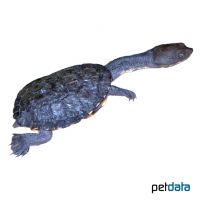Common Snake-necked Turtle (Chelodina longicollis)
| Common Snake-necked Turtle Chelodina longicollis | |
|---|---|
| Name | Common Snake-necked Turtle |
| Name Lat. | Chelodina longicollis |
| Family | Austro-American Sideneck Turtles |
| Family lat. | Chelidae |
| Order | Turtles |
| Order lat. | Testudines |
| Origin | SE-Australia |
| Habitat | Rivers, swamps |
| Diet | Dry food, fish, insects |
| Humidity | 60-80 % |
| Behavior | Aquatic |
| Keeping | Pair, group |
| Care Level | Moderate |
| Reproduction | Oviparous |
| Housing | Aquaterrarium |
| Life Span | 25-30 years |
| Protection | No |
| Metric Units | |
| Size | 20-28 cm |
| Temperature | 25-28 °C |
| Temperature Local | 35-40 °C |
| Housing Size | 180 x 80 x 80 cm |
| US Units | |
| Size | 8"-11" |
| Temperature | 77-82 °F |
| Temperature Local | 95-104 °F |
| Housing Size | 70" x 30" x 30" |
Distribution and habitat
The diurnal smoothback snake-necked turtles are widespread in Australia, from New South Wales to Queensland and South Australia. There they live in slow flowing waters and lakes as well as swamps and lagoons with dense vegetation.
Maintenance
Recommended minimum dimensions for the aquaterrarium, according to the size and number of animals
| Floor space for 1-2 animals: 5PL x 2,5PL (L x W) | Water level: 2PB |
The carapace length (PL) and carapace width (PB) is measured on the largest animal. For each additional animal, increase the footprint by 10%, and for the 5th animal and larger, increase the footprint by 20%. An aquaterrarium of e.g. L 180 x W 80 x H 80 cm is recommended, which should be placed in a quiet and vibration-free place.
The water part, with soft, muddy substrate, should be structured with roots, aquatic plants and larger stones (visibility barriers and hiding places), some of which reach the water surface. In addition, they need a small, sandy land part with plants and roots, as well as a place for sunbathing. To maintain water quality, a powerful filter with low flow and frequent water changes are recommended
| Water Temp | lighting | Sunny | |
| Summer | 25-27 °C | 12-14 hrs. | 35-40 °C |
| Winter (2-3 months) | 18-24 °C | 10-12 hrs |
Special lamps that produce the necessary heat and UV light are ideal. Daily UV irradiation is essential.
Diet
They feed mainly on animal food. The food supply consists of insect larvae, earthworms, meal beetle larvae and fish or a commercially available pelleted or freeze-dried ready-made food for aquatic turtles. Frozen food is also well accepted. In addition, they occasionally need plant food, such as lettuce, dandelion, endive, and aquatic plants (e.g., waterweed). Adult animals should be offered food twice a week. Regular addition of minerals and vitamins is important
A varied diet promotes health and prevents deficiency symptoms.
Reproduction and breeding
The males have a concave ventral carapace (plastron) and a much longer tail. Mating occurs year-round, but the end of the rainy season is preferred. Egg-laying occurs twice a year. The female buries her eggs (up to 20 eggs) near water bodies. The incubation period is 120-180 days at an average of 29° C. The young hatch at the beginning of the following rainy season.
Important
They need a large aquaterrarium and should not be socialized with other aquatic turtles. Although the animals are very compatible with each other, care must be taken to ensure that low ranking animals receive adequate food. Snake-necked turtles are almost exclusively aquatic. Occasionally, egg-laying occurs underwater in mud. Embryonic development in the egg does not begin until the body of water has dried up.
Particular attention should be paid to good water quality.
The terrarium must have good ventilation without drafts and meet the species-specific needs. Measuring devices such as thermometers, hygrometers, etc. are necessary. The lighting has to correspond to the species-specific day-night rhythm and has to be placed in such a way that the animals cannot injure themselves. The terrarium should be locked in such a way that neither unauthorized persons can open it nor the animals can escape. Contamination must be removed regularly
Further literature can be found in your pet store.
References
Text: petdata; Image: petdata
Source: BMELV (1997): Mindestanforderungen an die Haltung von Reptilien; ENGELMANN (2006): Zootierhaltung - Tiere in menschlicher Obhut: Reptilien und Amphibien, Harri Deutsch Verlag
- Gemäß § 21 Abs. 5 Tierschutzgesetz idgF
